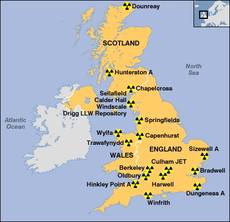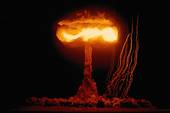The inconvenient truth about the climate-nuclear nexus
On 14 September 2011, Al Gore will follow up his award winning film “An Inconvenient Truth” with the Climate Reality Project, a 24-hour campaign aimed at revealing the complete truth of the climate crisis. The World Future Council supports and shares Al Gore’s goal to raise awareness for the climate change debate.
Revealing the “complete truth” about climate change should also include highlighting the important yet often neglected linkages between nuclear and climate risks.
The nuclear disaster in Fukushima in March has drawn attention to the possible effects of extreme weather events, environmental degradation and seismic activity on nuclear security and safety. In a recent WFC report, WFC Peace and Disarmament Working Group member Prof. Dr. Jürgen Scheffran of the University of Hamburg examines the multidimensional interplay between these two key dangers of our time: global warming and nuclear threats.
In line with the Climate Reality Project, here is a brief reality check on the climate-nuclear nexus.
Natural disasters and climate change-induced extreme weather events can have grave implications for nuclear security and safety
Recently, a number of natural disasters have demonstrated how extreme weather events and environmental degradation can directly cause severe threats for nuclear safety and security.
- The wildfires that spread through Russia in the summer of 2010 posed a severe nuclear risk to the country when they were on their way to engulf key nuclear sites. In addition, there was widespread concern that radionuclides from land contaminated by the 1986 Chernobyl nuclear disaster could rise together with combustion particles, resulting in a new pollution zone. Luckily, the authorities managed to contain the fires in time.
- In Pakistan, the climate-nuclear nexus becomes particularly apparent. Past natural disasters have heightened anxieties about the safety and security of Pakistan’s nuclear sites and military installations. So far, nuclear sites in the extreme weather-prone country have remained safe, yet concern exists about the possible damage from future natural disasters, as well as the security of Pakistan’s nuclear arsenal and materials during such events.
- The events in Japan earlier this year have demonstrated the potential catastrophic consequences of natural disasters for nuclear security. The 9.0-magnitude earthquake and subsequent tsunami that hit the country on 11 March 2011 caused major damage to the Fukushima Daiichi nuclear power plant, disabling the reactor cooling systems and triggering a widespread evacuation surrounding the plant. The nuclear crisis is still unfolding and it will be decades before a comprehensive impact assessment of the disaster can be made.
- In the UK, leading geologist Prof. Rob Duck of Dundee University has warned that if climate change continues it may lead to the erosion of Britain’s coast and may even cause tsunamis. This in turn will have critical implications for the safety of Britain’s nuclear power stations, all but one of which lie on the coast (Fig. 1).
Conflicts due to climate change can trigger the use of nuclear weapons
Recently, attention has also been drawn to the severe security risks of global warming. The fear concentrates on how large-scale cascading events in the climate system could lead to international instability. Conflicts due to climate change can trigger the use of nuclear weapons.
UN Secretary-General Ban Ki-moon has warned that climate change may pose as much of a danger to the world as war. In April 2007, the UN Security Council held its first debate on climate change indicating that global warming has elevated to the top of the international security agenda, rivalling the threat of war. In a 2008 report, the European Commission noted that “[c]limate change is best viewed as a threat multiplier which exacerbates existing trends, tensions and instability. The core challenge is that climate change threatens to overburden states and regions which are already fragile and conflict prone.”
Nuclear weapons represent a particularly worrying element in this volatile equation. International destabilization resulting from climate change could provoke conflicts, which, in turn, could enhance the chance of a nuclear weapon being used, could create more fertile breeding grounds of terrorism, including the nuclear kind, and could feed the ambitions among some states to acquire nuclear arms.
If climate change is a threat multiplier which exacerbates existing trends, tensions and instability, then nuclear weapons are capable of raising the stakes exponentially.
Nuclear energy is no solution to fossil energy dependence and global warming
Nuclear power is fraught with security risks and a variety of other problems. Firstly, radioactive materials are released and accumulated at each stage of the nuclear fuel cycle, while errors and accidents during the generation process further contribute to the threat of radioactive contamination.
Secondly, nuclear power is inextricably linked to nuclear weapons development. So far, about one-third of the countries using nuclear power have built nuclear weapons. At various stages of the nuclear fuel chain, transitions to nuclear weapons technology are possible, contributing to the danger of their worldwide proliferation. A serious problem is the civil-military ambivalence of nuclear technologies and facilities involved in the production and processing of weapons-grade materials. These include uranium enrichment, fuel production and reprocessing of spent nuclear fuel. Around 20 countries already have access to such technologies. This trend would increase with a further global expansion of nuclear energy.
The global inventory of highly enriched uranium totals around 1600 tons, while the global stockpile of separated plutonium is about 500 tons, divided almost equally between civilian and military stocks. One hundred tons of plutonium is theoretically sufficient for up to 20,000 nuclear warheads. With increasing civilian use, the amount of plutonium also tends to increase. The difficulty in distinguishing between civilian and military nuclear ambitions remains a source for discrimination, threat, mistrust and fear in international relations.
Thirdly, even a drastic increase in nuclear energy could not compensate for the current growth in energy consumption; it would come too late for preventing climate change and lead to an enormous increase in plutonium stocks, with all its aforementioned problems.
Fourthly, although nuclear power has been heavily subsidised by governments and external costs are still not internalised into its market price, nuclear energy is not commercially competitive compared to advanced renewable energies that receive similar financial support. In a comprehensive environmental and economic assessment, including external costs from waste disposal, uranium mining, fuel processing and radioactive emissions during normal operations, most renewable energy sources look better than nuclear energy.
Finally, nuclear waste disposal (whether from nuclear power production, nuclear weapons programs or nuclear disarmament) will remain a problem for thousands of years, and many future generations will have to bear this load without having the short-term “benefit” of the current generation. To decay half of the amount of plutonium 239, which is the primary fissile isotope used for the production of nuclear weapons, it takes around 24000 years or 1000 human generations, much longer than the known history of homo sapiens. After decades of nuclear energy production, the pile of nuclear waste is still growing, even though worldwide not a single site for final disposal of spent fuels is operating and temporary storage is continuously being extended. It is uncertain whether and when a responsible solution to the long-term disposal of radioactive waste can be found.
Abolition 2000
Abolition 2000 links organisations and initiatives around the world working for the elimination of nuclear weapons through a global treaty, and promotes simultaneous action on steps and measures supporting that goal. Abolition 2000 also calls for the phase-out of nuclear power and development of sustainable and environmentally safe energy sources.
On 16 September, two days after Al Gore’s Climate Reality Project, Abolition 2000 will hold its Annual Meeting in Geneva. The meeting will review the efforts of the network, which includes more than 2000 organizations in over 90 countries, examine regional perspectives and the efforts of our various working groups and affiliated networks. It will strategise to achieve a world free of nuclear weapons and discuss outreach and collaboration with initiatives like Mayors for Peace, Parliamentarians for Nuclear Nonproliferation and Disarmament (PNND), and the International Campaign for the Abolition of Nuclear Weapons (ICAN).






